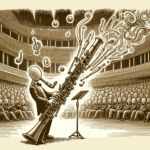Exploring Clarinet Effects Pedals: A New Frontier in Woodwind Music
Clarinet effects pedals might not be the first thing that comes to mind when you think of traditional woodwind music, but these devices are changing what the instrument can do in amazing ways! Whether you're after a rich, reverb-laden soundscape for a solo performance or a gritty distortion for an experimental track, effects pedals can take your clarinet playing to new heights. Let's explore how these devices work, how to start using them, and why they've become an exciting tool for modern clarinetists, no matter their skill level.
What Are Effects Pedals?
Effects pedals are small electronic devices that modify and enhance sound. While often associated with guitarists, they can work wonders for clarinets too. These pedals can add echo, delay, or pitch shifts—they can even make your clarinet sound like a completely different instrument! To use one with a clarinet, you'll need a microphone pickup near your instrument's bell. This sends the signal into the pedal, which then processes the sound before outputting it to an amplifier or speaker.
| Effect Type | Description | Common Use |
|---|---|---|
| Reverb | Adds depth and space to the sound | Solo performances, ballads |
| Delay | Creates echoes of the original sound | Rhythmic patterns, layered sounds |
| Distortion | Adds grit and texture to the tone | Experimental music, rock-inspired pieces |
Unleashing Creative Freedom
One of the biggest attractions of clarinet effects pedals is the creative freedom they offer. You can craft dreamy soundscapes for jazz tunes or create haunting atmospheres for theatrical performances. Adding effects doesn't mean losing your clarinet's unique tone. Instead, these pedals enhance your sound while allowing you to experiment with its character. Many Martin Freres clarinet players find that their instruments' exceptional tonal clarity works beautifully with these sonic transformations.
Getting Started with Effects Pedals
Curious about trying effects pedals? Start simple. For beginners, a reverb pedal is often a great first choice. Reverb makes your sound longer and richer by mimicking the acoustic properties of different spaces, from grand concert halls to cozy living rooms. Adding an echo-like shimmer with a reverb pedal can truly elevate your playing. Many musicians discover new depth and warmth in their sound with just a few adjustments to the settings.
Exploring Delay Pedals
As you get more comfortable, delay pedals can offer stunning effects to enhance your rhythm and phrasing. These pedals create cascading echoes—it's almost like having a duet partner following your lead a moment after each note you play. It's easy to see why many forward-thinking musicians love using delay pedals in their performances.
Pushing Boundaries with Distortion Pedals
For those feeling adventurous, distortion pedals can add grit and texture to your sound. While these settings might surprise traditionalists, they open up new possibilities for taking the clarinet beyond classical boundaries. When paired with the rich tone of Martin Freres Clarinets, the result is a fascinating blend of classic quality and modern edge.
Technical Tips for Using Effects Pedals
When setting up effects for your clarinet, clear signal quality is crucial. It's tempting to use multiple pedals at once, but start with just one and perfect its use before adding more. This approach leads to more refined results than trying to use every effect simultaneously.
Remember to balance the pedal settings with your instrument's natural tone. High-quality clarinets like those from Martin Freres have a beautiful sound that you don't want to overpower. Be mindful of how much effect you're adding, and don't hesitate to compare the processed sound with your natural tone to ensure you're achieving your desired artistic expression.
Tips for Live Performance
If you're using effects in live performances, practice your pedal technique! Switching between effects can be challenging under pressure. Set up your songs in advance and get comfortable with your timing to avoid mid-performance issues. For more complex setups, multi-effects units with preset options can be incredibly helpful, especially if you're playing various styles from night to night.
The Art of Layering Effects
Don't be afraid to experiment with combining effects! Mixing distortion with delay can create interesting textures, while pairing reverb with a slow tremolo might produce a mesmerizing backdrop for vibrato-rich passages. Think of it as painting with sound—your clarinet is the brush, and the pedals offer endless colors to blend and explore.
Embracing New Possibilities
Musicians today are expanding the boundaries of clarinet music. Effects pedals offer exciting possibilities for everyone, whether you're just starting to explore or you're already deep into experimentation. If you're playing a Martin Freres Clarinet, you've got an excellent foundation to build upon. Why not give it a try? Add an effects pedal or two to your setup and discover new ways to make your clarinet shine!
Table of Contents
- Exploring Clarinet Effects Pedals: A New Frontier in Woodwind Music
- What Are Effects Pedals?
- Unleashing Creative Freedom
- Getting Started with Effects Pedals
- Exploring Delay Pedals
- Pushing Boundaries with Distortion Pedals
- Technical Tips for Using Effects Pedals
- Tips for Live Performance
- The Art of Layering Effects
- Embracing New Possibilities







